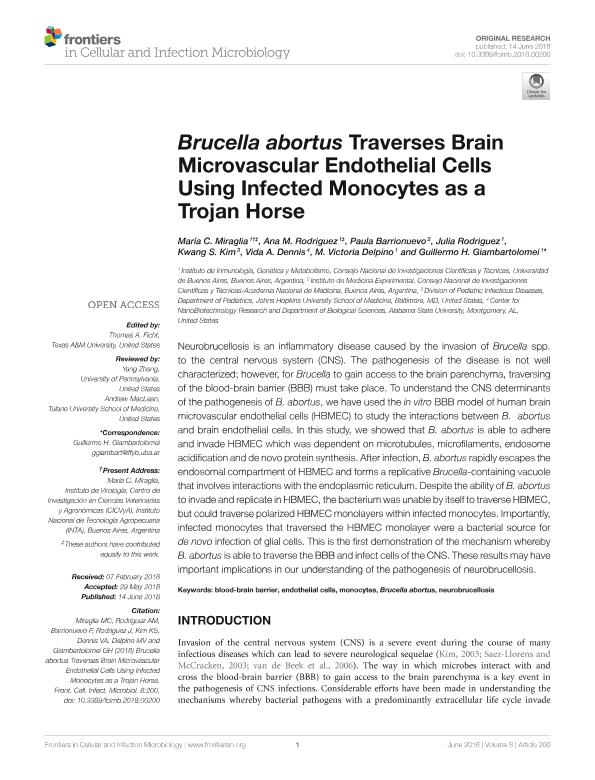Mostrar el registro sencillo del ítem
dc.contributor.author
Miraglia, Maria Cruz

dc.contributor.author
Rodríguez, Ana María

dc.contributor.author
Barrionuevo, Paula

dc.contributor.author
Rodríguez, Julia

dc.contributor.author
Kim, Kwang S.
dc.contributor.author
Dennis, Vida A.
dc.contributor.author
Delpino, María Victoria

dc.contributor.author
Giambartolomei, Guillermo Hernan

dc.date.available
2020-01-27T23:07:16Z
dc.date.issued
2018-06
dc.identifier.citation
Miraglia, Maria Cruz; Rodríguez, Ana María; Barrionuevo, Paula; Rodríguez, Julia; Kim, Kwang S.; et al.; Brucella abortus traverses brain microvascular endothelial cells using infected monocytes as a Trojan horse; Frontiers Media S.A.; Frontiers in Cellular and Infection Microbiology; 8; 6-2018; 1-11
dc.identifier.issn
2235-2988
dc.identifier.uri
http://hdl.handle.net/11336/95947
dc.description.abstract
Neurobrucellosis is an inflammatory disease caused by the invasion of Brucella spp. to the central nervous system (CNS). The pathogenesis of the disease is not well characterized; however, for Brucella to gain access to the brain parenchyma, traversing of the blood-brain barrier (BBB) must take place. To understand the CNS determinants of the pathogenesis of B. abortus, we have used the in vitro BBB model of human brain microvascular endothelial cells (HBMEC) to study the interactions between B. abortus and brain endothelial cells. In this study, we showed that B. abortus is able to adhere and invade HBMEC which was dependent on microtubules, microfilaments, endosome acidification and de novo protein synthesis. After infection, B. abortus rapidly escapes the endosomal compartment of HBMEC and forms a replicative Brucella-containing vacuole that involves interactions with the endoplasmic reticulum. Despite the ability of B. abortus to invade and replicate in HBMEC, the bacterium was unable by itself to traverse HBMEC, but could traverse polarized HBMEC monolayers within infected monocytes. Importantly, infected monocytes that traversed the HBMEC monolayer were a bacterial source for de novo infection of glial cells. This is the first demonstration of the mechanism whereby B. abortus is able to traverse the BBB and infect cells of the CNS. These results may have important implications in our understanding of the pathogenesis of neurobrucellosis.
dc.format
application/pdf
dc.language.iso
eng
dc.publisher
Frontiers Media S.A.

dc.rights
info:eu-repo/semantics/openAccess
dc.rights.uri
https://creativecommons.org/licenses/by/2.5/ar/
dc.subject
BLOOD-BRAIN BARRIER
dc.subject
BRUCELLA ABORTUS
dc.subject
ENDOTHELIAL CELLS
dc.subject
MONOCYTES
dc.subject
NEUROBRUCELLOSIS
dc.subject.classification
Enfermedades Infecciosas

dc.subject.classification
Ciencias de la Salud

dc.subject.classification
CIENCIAS MÉDICAS Y DE LA SALUD

dc.title
Brucella abortus traverses brain microvascular endothelial cells using infected monocytes as a Trojan horse
dc.type
info:eu-repo/semantics/article
dc.type
info:ar-repo/semantics/artículo
dc.type
info:eu-repo/semantics/publishedVersion
dc.date.updated
2019-10-16T20:36:37Z
dc.journal.volume
8
dc.journal.pagination
1-11
dc.journal.pais
Suiza

dc.journal.ciudad
Lausana
dc.description.fil
Fil: Miraglia, María C..
dc.journal.title
Frontiers in Cellular and Infection Microbiology
dc.relation.alternativeid
info:eu-repo/semantics/altIdentifier/url/https://www.frontiersin.org/article/10.3389/fcimb.2018.00200/full
dc.relation.alternativeid
info:eu-repo/semantics/altIdentifier/doi/http://dx.doi.org/10.3389/fcimb.2018.00200
Archivos asociados
